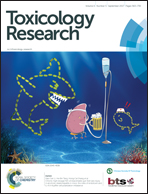Organochlorine compounds in the adipose tissue of urban and rural women who gave birth by cesarean delivery in northern Turkey
Abstract
In this study, the levels of a group of organochlorine pesticides (OCPs) and polychlorinated biphenyls (PCBs) in the adipose tissue of women living in northern Turkey who gave birth by cesarean delivery were investigated. Sixty subcutaneous samples were collected in 2013 from women in urban (30) and rural (30) areas. The levels of nine OCPs, namely α-hexachlorocyclohexane (HCH), β-HCH (lindane), γ-HCH, hexachlorobenzene (HCB), aldrin, and dichlorodiphenyltrichloroethane (DDT) and its metabolites, 2,4′-dichlorodiphenyldichloroethylene (DDE), 4,4′-DDE, 2,4′-DDT, 4,4′-DDT, and 16 PCBs, PCB-28, -52, -70, -74, -81, -99, -101, -118, -138, -153, -156, -170, -180, -183, -187 and -208, were investigated with a gas chromatograph equipped with an electron capture detector (GC-ECD). β-HCH was detected in nine samples (mean 23.70 ± 4.24 ng g−1 of fat) and γ-HCH was detected in six samples (mean 41.88 ± 12.41 ng g−1 of fat). HCB was detected in five samples (mean 30.97 ± 14.31 ng g−1 of fat), 2,4′-DDT in one sample (5 ng g−1 of fat), 4,4-DDT in two samples (mean 6.70 ± 0.42 ng g−1 of fat), 2,4′-dichlorodiphenyldichloroethylene in three samples (mean 6.27 ± 0.42 ng g−1 of fat), PCB-28 in six samples (mean 10.03 ± 7.79 ng g−1 of fat), PCB-81 in one sample (7.60 ng g−1 of fat) and PCB-118 in one sample (10.20 ng g−1 of fat). In total, organochlorine compounds were detected in 12 (40%) of rural and 12 (40%) of urban women. These results are an indication of the level of organochlorine compounds in the environment where the subjects of the study lived.



 Please wait while we load your content...
Please wait while we load your content...